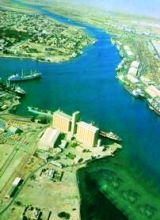Port Sudan struggles to expand in divided land
By Lloyds List
June 15, 2005 — SUDAN is the largest country in Africa. It is also one of the most conflict-torn, the victim of not just one, but two deadly civil wars.
 Conflict between the Muslim and Arabic north and the animist and Christian black south rumbled on for over two decades until a peace deal was signed earlier this year. The fighting cost 1.5m lives.
Conflict between the Muslim and Arabic north and the animist and Christian black south rumbled on for over two decades until a peace deal was signed earlier this year. The fighting cost 1.5m lives.
In addition, separatist rebels in the western region of Darfur launched an insurrection in 2003, which was bloodily quelled when pro-government militias launched a campaign of ethnic cleansing that probably merits the description genocide. US sanctions have resulted.
The political problems in this inherently divided land seem all but insurmountable. But this could be a prosperous country. There are large areas of cultivable land, as well as significant quantities of oil.
Port Sudan – situated on an inlet from the Red Sea – has been the country’s chief deepwater port for the last 100 years.
Work on the port was commenced by the British in 1905, who built it primarily to serve a railway line to the capital Khartoum.
Thanks largely to international development aid, modernisation commenced in the late seventies, with the addition of extra berths and ro-ro and container facilities. Road links were improved to give trucks better access.
The government reportedly has plans for further improvements, including a complete overhaul of the rail link.
Principal exports are live cattle and sheep, hides and skins, gum arabic, cotton, molasses and hibiscus.
Port Sudan is currently being used by the United Nations’ World Food Programme for the shipment of relief cargoes bound for Darfur.
Critics have claimed that the port is simply not up to the task of handling the expected volumes that this will entail. But the harbour master last year assured Lloyd’s List that this is unlikely to be the case.
The port has 6,000 permanent employees and a large pool of casual labour.
Lack of congestion means that vessels can be turned around within 24 hours, he said.
New berths have been constructed on the outside wall of the north quay, and more are planned to cope with an expected increase in business, Hashim Rachman Ali added.
However, there have been reports of disturbances nearby in recent months. After one demonstration held last January, the security forces killed 14 protestors.
Until the construction of Port Sudan, the country’s main port was Suakin, some 63km further south. Largely disused throughout most of the 20th century, the idea of reviving it was first kicked about in the seventies, with work commencing the following decade.
After many problems – largely flowing from government procrastination – it opened for business in January 1991. It remains small, and can only accommodate coastal vessels of up to 6,000 dwt.
Among the agencies serving the country is Baasher Barwil Agencies, a joint venture between Norway’s Wilh. Wilhelmsen and Baasher family, which has been running an agency in Port Sudan since 1941. It provides a full range of marine services, including liner representation, stevedoring, port husbandry, bunkering and clearance.
